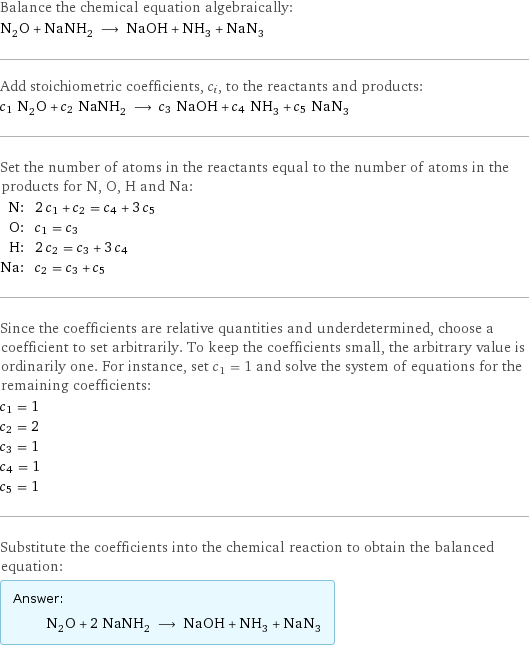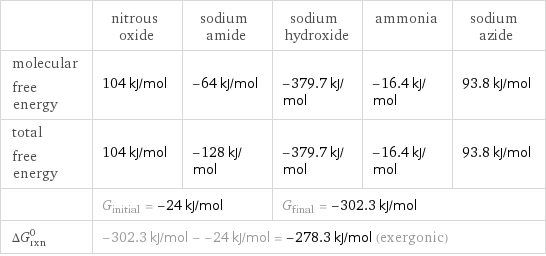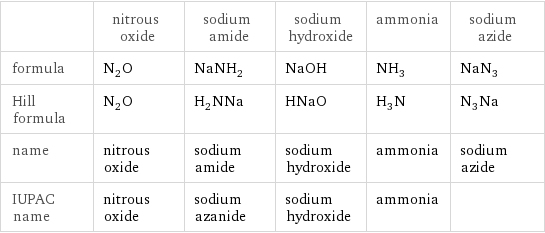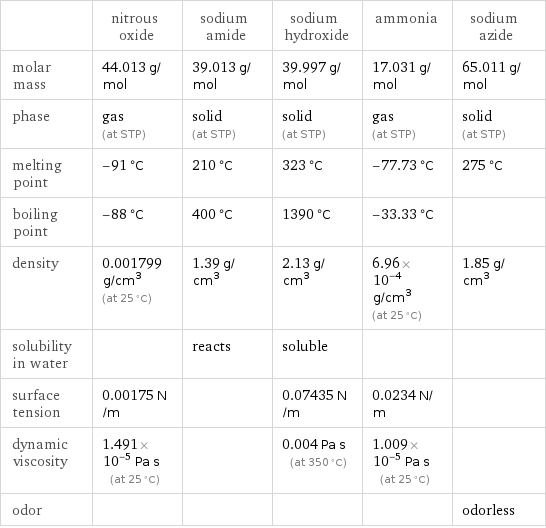Input interpretation

N_2O nitrous oxide + NaNH_2 sodium amide ⟶ NaOH sodium hydroxide + NH_3 ammonia + NaN_3 sodium azide
Balanced equation

Balance the chemical equation algebraically: N_2O + NaNH_2 ⟶ NaOH + NH_3 + NaN_3 Add stoichiometric coefficients, c_i, to the reactants and products: c_1 N_2O + c_2 NaNH_2 ⟶ c_3 NaOH + c_4 NH_3 + c_5 NaN_3 Set the number of atoms in the reactants equal to the number of atoms in the products for N, O, H and Na: N: | 2 c_1 + c_2 = c_4 + 3 c_5 O: | c_1 = c_3 H: | 2 c_2 = c_3 + 3 c_4 Na: | c_2 = c_3 + c_5 Since the coefficients are relative quantities and underdetermined, choose a coefficient to set arbitrarily. To keep the coefficients small, the arbitrary value is ordinarily one. For instance, set c_1 = 1 and solve the system of equations for the remaining coefficients: c_1 = 1 c_2 = 2 c_3 = 1 c_4 = 1 c_5 = 1 Substitute the coefficients into the chemical reaction to obtain the balanced equation: Answer: | | N_2O + 2 NaNH_2 ⟶ NaOH + NH_3 + NaN_3
Structures

+ ⟶ + +
Names

nitrous oxide + sodium amide ⟶ sodium hydroxide + ammonia + sodium azide
Reaction thermodynamics
Enthalpy

| nitrous oxide | sodium amide | sodium hydroxide | ammonia | sodium azide molecular enthalpy | 81.6 kJ/mol | -123.8 kJ/mol | -425.8 kJ/mol | -45.9 kJ/mol | 21.7 kJ/mol total enthalpy | 81.6 kJ/mol | -247.6 kJ/mol | -425.8 kJ/mol | -45.9 kJ/mol | 21.7 kJ/mol | H_initial = -166 kJ/mol | | H_final = -450 kJ/mol | | ΔH_rxn^0 | -450 kJ/mol - -166 kJ/mol = -284 kJ/mol (exothermic) | | | |
Gibbs free energy

| nitrous oxide | sodium amide | sodium hydroxide | ammonia | sodium azide molecular free energy | 104 kJ/mol | -64 kJ/mol | -379.7 kJ/mol | -16.4 kJ/mol | 93.8 kJ/mol total free energy | 104 kJ/mol | -128 kJ/mol | -379.7 kJ/mol | -16.4 kJ/mol | 93.8 kJ/mol | G_initial = -24 kJ/mol | | G_final = -302.3 kJ/mol | | ΔG_rxn^0 | -302.3 kJ/mol - -24 kJ/mol = -278.3 kJ/mol (exergonic) | | | |
Equilibrium constant
![Construct the equilibrium constant, K, expression for: N_2O + NaNH_2 ⟶ NaOH + NH_3 + NaN_3 Plan: • Balance the chemical equation. • Determine the stoichiometric numbers. • Assemble the activity expression for each chemical species. • Use the activity expressions to build the equilibrium constant expression. Write the balanced chemical equation: N_2O + 2 NaNH_2 ⟶ NaOH + NH_3 + NaN_3 Assign stoichiometric numbers, ν_i, using the stoichiometric coefficients, c_i, from the balanced chemical equation in the following manner: ν_i = -c_i for reactants and ν_i = c_i for products: chemical species | c_i | ν_i N_2O | 1 | -1 NaNH_2 | 2 | -2 NaOH | 1 | 1 NH_3 | 1 | 1 NaN_3 | 1 | 1 Assemble the activity expressions accounting for the state of matter and ν_i: chemical species | c_i | ν_i | activity expression N_2O | 1 | -1 | ([N2O])^(-1) NaNH_2 | 2 | -2 | ([NaNH2])^(-2) NaOH | 1 | 1 | [NaOH] NH_3 | 1 | 1 | [NH3] NaN_3 | 1 | 1 | [NaN3] The equilibrium constant symbol in the concentration basis is: K_c Mulitply the activity expressions to arrive at the K_c expression: Answer: | | K_c = ([N2O])^(-1) ([NaNH2])^(-2) [NaOH] [NH3] [NaN3] = ([NaOH] [NH3] [NaN3])/([N2O] ([NaNH2])^2)](../image_source/fa100ce44623b1e61bf753b648bfca2a.png)
Construct the equilibrium constant, K, expression for: N_2O + NaNH_2 ⟶ NaOH + NH_3 + NaN_3 Plan: • Balance the chemical equation. • Determine the stoichiometric numbers. • Assemble the activity expression for each chemical species. • Use the activity expressions to build the equilibrium constant expression. Write the balanced chemical equation: N_2O + 2 NaNH_2 ⟶ NaOH + NH_3 + NaN_3 Assign stoichiometric numbers, ν_i, using the stoichiometric coefficients, c_i, from the balanced chemical equation in the following manner: ν_i = -c_i for reactants and ν_i = c_i for products: chemical species | c_i | ν_i N_2O | 1 | -1 NaNH_2 | 2 | -2 NaOH | 1 | 1 NH_3 | 1 | 1 NaN_3 | 1 | 1 Assemble the activity expressions accounting for the state of matter and ν_i: chemical species | c_i | ν_i | activity expression N_2O | 1 | -1 | ([N2O])^(-1) NaNH_2 | 2 | -2 | ([NaNH2])^(-2) NaOH | 1 | 1 | [NaOH] NH_3 | 1 | 1 | [NH3] NaN_3 | 1 | 1 | [NaN3] The equilibrium constant symbol in the concentration basis is: K_c Mulitply the activity expressions to arrive at the K_c expression: Answer: | | K_c = ([N2O])^(-1) ([NaNH2])^(-2) [NaOH] [NH3] [NaN3] = ([NaOH] [NH3] [NaN3])/([N2O] ([NaNH2])^2)
Rate of reaction
![Construct the rate of reaction expression for: N_2O + NaNH_2 ⟶ NaOH + NH_3 + NaN_3 Plan: • Balance the chemical equation. • Determine the stoichiometric numbers. • Assemble the rate term for each chemical species. • Write the rate of reaction expression. Write the balanced chemical equation: N_2O + 2 NaNH_2 ⟶ NaOH + NH_3 + NaN_3 Assign stoichiometric numbers, ν_i, using the stoichiometric coefficients, c_i, from the balanced chemical equation in the following manner: ν_i = -c_i for reactants and ν_i = c_i for products: chemical species | c_i | ν_i N_2O | 1 | -1 NaNH_2 | 2 | -2 NaOH | 1 | 1 NH_3 | 1 | 1 NaN_3 | 1 | 1 The rate term for each chemical species, B_i, is 1/ν_i(Δ[B_i])/(Δt) where [B_i] is the amount concentration and t is time: chemical species | c_i | ν_i | rate term N_2O | 1 | -1 | -(Δ[N2O])/(Δt) NaNH_2 | 2 | -2 | -1/2 (Δ[NaNH2])/(Δt) NaOH | 1 | 1 | (Δ[NaOH])/(Δt) NH_3 | 1 | 1 | (Δ[NH3])/(Δt) NaN_3 | 1 | 1 | (Δ[NaN3])/(Δt) (for infinitesimal rate of change, replace Δ with d) Set the rate terms equal to each other to arrive at the rate expression: Answer: | | rate = -(Δ[N2O])/(Δt) = -1/2 (Δ[NaNH2])/(Δt) = (Δ[NaOH])/(Δt) = (Δ[NH3])/(Δt) = (Δ[NaN3])/(Δt) (assuming constant volume and no accumulation of intermediates or side products)](../image_source/cd11dd56f988accca6d7f2309c4d42ef.png)
Construct the rate of reaction expression for: N_2O + NaNH_2 ⟶ NaOH + NH_3 + NaN_3 Plan: • Balance the chemical equation. • Determine the stoichiometric numbers. • Assemble the rate term for each chemical species. • Write the rate of reaction expression. Write the balanced chemical equation: N_2O + 2 NaNH_2 ⟶ NaOH + NH_3 + NaN_3 Assign stoichiometric numbers, ν_i, using the stoichiometric coefficients, c_i, from the balanced chemical equation in the following manner: ν_i = -c_i for reactants and ν_i = c_i for products: chemical species | c_i | ν_i N_2O | 1 | -1 NaNH_2 | 2 | -2 NaOH | 1 | 1 NH_3 | 1 | 1 NaN_3 | 1 | 1 The rate term for each chemical species, B_i, is 1/ν_i(Δ[B_i])/(Δt) where [B_i] is the amount concentration and t is time: chemical species | c_i | ν_i | rate term N_2O | 1 | -1 | -(Δ[N2O])/(Δt) NaNH_2 | 2 | -2 | -1/2 (Δ[NaNH2])/(Δt) NaOH | 1 | 1 | (Δ[NaOH])/(Δt) NH_3 | 1 | 1 | (Δ[NH3])/(Δt) NaN_3 | 1 | 1 | (Δ[NaN3])/(Δt) (for infinitesimal rate of change, replace Δ with d) Set the rate terms equal to each other to arrive at the rate expression: Answer: | | rate = -(Δ[N2O])/(Δt) = -1/2 (Δ[NaNH2])/(Δt) = (Δ[NaOH])/(Δt) = (Δ[NH3])/(Δt) = (Δ[NaN3])/(Δt) (assuming constant volume and no accumulation of intermediates or side products)
Chemical names and formulas

| nitrous oxide | sodium amide | sodium hydroxide | ammonia | sodium azide formula | N_2O | NaNH_2 | NaOH | NH_3 | NaN_3 Hill formula | N_2O | H_2NNa | HNaO | H_3N | N_3Na name | nitrous oxide | sodium amide | sodium hydroxide | ammonia | sodium azide IUPAC name | nitrous oxide | sodium azanide | sodium hydroxide | ammonia |
Substance properties

| nitrous oxide | sodium amide | sodium hydroxide | ammonia | sodium azide molar mass | 44.013 g/mol | 39.013 g/mol | 39.997 g/mol | 17.031 g/mol | 65.011 g/mol phase | gas (at STP) | solid (at STP) | solid (at STP) | gas (at STP) | solid (at STP) melting point | -91 °C | 210 °C | 323 °C | -77.73 °C | 275 °C boiling point | -88 °C | 400 °C | 1390 °C | -33.33 °C | density | 0.001799 g/cm^3 (at 25 °C) | 1.39 g/cm^3 | 2.13 g/cm^3 | 6.96×10^-4 g/cm^3 (at 25 °C) | 1.85 g/cm^3 solubility in water | | reacts | soluble | | surface tension | 0.00175 N/m | | 0.07435 N/m | 0.0234 N/m | dynamic viscosity | 1.491×10^-5 Pa s (at 25 °C) | | 0.004 Pa s (at 350 °C) | 1.009×10^-5 Pa s (at 25 °C) | odor | | | | | odorless
Units
